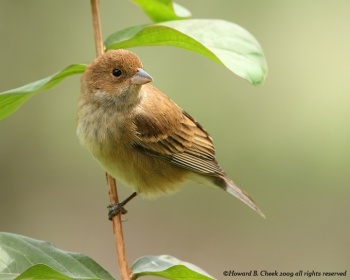(Picture placement, References updated, Video link) |
(→Taxonomy: Update link) |
||
| Line 16: | Line 16: | ||
Breeds throughout the eastern [[United States]] east of eastern [[North Dakota]], western [[Colorado]], and western [[New Mexico]]. Rare to uncommon west of range. Winters south to [[Greater Antilles]], [[Central America]], [[Colombia]] and [[Venezuela]]. Accidental vagrant to the [[UK]] and [[Sweden]]. | Breeds throughout the eastern [[United States]] east of eastern [[North Dakota]], western [[Colorado]], and western [[New Mexico]]. Rare to uncommon west of range. Winters south to [[Greater Antilles]], [[Central America]], [[Colombia]] and [[Venezuela]]. Accidental vagrant to the [[UK]] and [[Sweden]]. | ||
==Taxonomy== | ==Taxonomy== | ||
| − | This is a [[Dictionary_M- | + | This is a [[Dictionary_M-O#M|monotypic]] species<sup>[[#References|[1]]]</sup>. |
| + | |||
==Habitat== | ==Habitat== | ||
Brushy slopes, abandoned farmland, old pastures and fields grown to scrub, woodland clearings, and forest edges adjacent to fields. | Brushy slopes, abandoned farmland, old pastures and fields grown to scrub, woodland clearings, and forest edges adjacent to fields. | ||
Revision as of 20:29, 12 July 2014
- Passerina cyanea
Identification
L. 5 1/2" (14 cm)
Male:
- Bright blue, almost iridescent plumage (color produced by diffraction)
- Crown is darker with a purple tint
- Wings and tail have some black
Female:
- Plain brown
- Paler beneath
Similar Species
Blue Grosbeak, which is bigger and has rusty wingbars; Blue Bunting is very similar, but has a dark blue body, brighter blue supercilium and forecrown and is only occasionally found in the USA, in extreme south Texas, as a vagrant.
Distribution
Breeds throughout the eastern United States east of eastern North Dakota, western Colorado, and western New Mexico. Rare to uncommon west of range. Winters south to Greater Antilles, Central America, Colombia and Venezuela. Accidental vagrant to the UK and Sweden.
Taxonomy
This is a monotypic species[1].
Habitat
Brushy slopes, abandoned farmland, old pastures and fields grown to scrub, woodland clearings, and forest edges adjacent to fields.
Behaviour
Diet
Forages in trees, shrubs and on the ground for insects, buds, berries and seeds.
Breeding
A compact woven cup of leaves and grass is built in bush or sapling in quite thick vegetation, a few feet from the ground. The 3 or 4 white to pale blue eggs are incubated by the female for 12 to 14 days.
Vocalisation
A fast, lively warble, with each phrase or note repeated twice.
References
- Clements, J. F., T. S. Schulenberg, M. J. Iliff, B.L. Sullivan, C. L. Wood, and D. Roberson. 2013. The eBird/Clements checklist of birds of the world: Version 6.8., with updates to August 2013. Downloaded from http://www.birds.cornell.edu/clementschecklist/download/
- eNature
Recommended Citation
- BirdForum Opus contributors. (2024) Indigo Bunting. In: BirdForum, the forum for wild birds and birding. Retrieved 26 April 2024 from https://www.birdforum.net/opus/Indigo_Bunting
External Links





